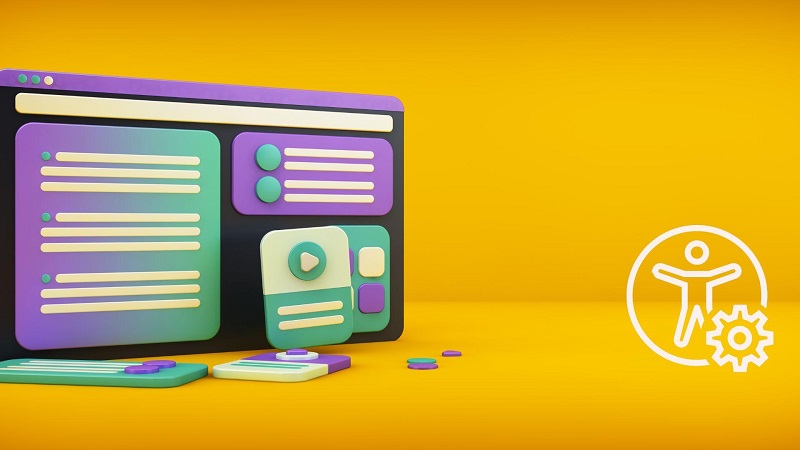
Statistics reveal WordPress as a popular content management system (CMS), with 43% of all websites using one of its versions. Despite its widespread use, web accessibility still requires awareness and discussion. With the site giving creators control over all aspects of their content, web developers can develop websites with better user experiences.
Why Accessibility Matters for WordPress Websites
Accessibility in WordPress means making the website accessible to as many users as possible, including the visually impaired and persons relying on assistive technology. The following are reasons why accessibility matters for WordPress websites.
Helps Avoid Legal Complaints
When operating your WordPress website in the US, an ADA-compliant web design is crucial to avoid legal complaints. Big companies like Netflix and Amazon have experienced web accessibility complaints, and adherence will save your business huge fines, a damaged reputation, and other implications.
Widens Your Reach
By making your WordPress website accessible, you will expand your target market reach. With more users suffering from disabilities, making your website accessible ensures easy navigation, guaranteeing recommendations and repeat visits.
Improves Your Ranking
During website ranking, accessibility is a top consideration besides the targeted keywords. Therefore, ensure that transcripts, video captions, and alt text are available to help persons with disabilities access your websites. Besides helping the users, the above features enable search engines to understand the video and image purposes. With a better understanding of your website by search engines, there is a high likelihood of a higher rank on the search engine result page.
Impacts Your Brand Reputation
An accessible website will attract more visitors and positively impact them. If users are convinced that the website is made for them, they will talk about your website and recommend it to others, enhancing your brand reputation.
9 Common WordPress Accessibility Issues
The following are examples of common WordPress accessibility issues.
Inappropriate Color Contrast
Where the font color and background are not distinct, persons with color blindness and other visual challenges will have trouble reading your content. Therefore, consider the WCAG guidelines on color contrast and maintain a 4:5:1 color contrast and a minimum of 3:1.
Missing (or Misused) Semantic Markup
Semantic markup gives programmatically determinable names for the elements in your website. Ideally, the semantic HTML explains the structure of the page. By using titles, subheadings, classes, and ID names, your website will function predictably whether your users use assistive technology or screen readers.
To avoid missing or misused semantic markups, use plain HTML to structure your content and Cascading Style Sheets (CSS) for your visual appearance. With CSS use being challenging among users, utilize web development service providers for CMS installation and adjustment, theme creation, and plugins to organize your web content in an accessible way.
Inaccessible Fonts
Inaccessible fonts make it difficult to distinguish characters and letters, reducing reading speed. Therefore, consider the recommended font and adequate font resizing to improve the readability of the information. Accessible fonts include Calibri, Helvetica, Tahoma, Verdana, Arial, and Times New Roman.
Missing Alternative Texts
Image alternative texts convert text to audio, giving users another way to understand the function of your images when they cannot perceive them visually. Failure to provide image descriptions will make your users miss out on important content, hence the need to understand best practices in writing alt texts.
Keyboard Accessibility Barriers
WordPress can also have accessibility barriers, especially where the plugin needs user interaction. For instance, if the chat window is inaccessible, you will lock out most of your audience that cannot use a mouse to close the chat window to read content. Hence, check your WordPress website for easy navigation with a keyboard.
Missing Skip Links
To bypass blocks of repeated content, users rely on skip links. Users may not want to listen to your header menu whenever they scroll to a new page. With a “skip to content” link, you will improve your user experience.
Form Time Outages
Forms are an important feature in any WordPress website; you may need to fill out one or two occasionally. At the same time, they can be a big hindrance to accessibility, especially where they self-terminate after a set period. While form time outages are a security feature, especially for those requiring financial input, they can restrict your users as not all can fill them within the given time. Therefore, consider extending the time or giving a warning when the form is about to expire.
Lack of Descriptive Links
Links allow users to navigate from one page to another. However, links may not be immediately clear for persons with poor vision or using screen readers, especially if they pop out of context. A hyperlink saying Click here is not descriptive enough about where it takes the users. Therefore, to ensure your WordPress accessibility, consider using descriptive links that help your website visitors figure out what the link is all about and where it will take them.
Motion Control Issues
It is becoming common for websites to have automated media, including graphics, GIFs, pop-ups, and vectors. For WordPress accessibility, allow your users to choose manually the media they prefer to run and give them a wide range of control, such as turning the media elements on or off. This way, you will also improve your page load speed and make the site less resource-heavy for those with unstable or poor internet connections.
Breaking Accessibility Barriers
Besides ranking your website and building a good brand reputation, website accessibility is critical to making an inclusive WordPress website that everyone can use, including specially-abled ones. Breaking accessibility barriers by addressing missing skip links, motion control, form time outages, descriptive links, and keyboard accessibility will ensure easy user navigation, improve your SEO ranking, and improve your brand.
About the Author

David Gevorkian
CEO/Founder
David started Be Accessible because of his passion for website accessibility and ADA compliance. He spent much of his career working for financial institutions creating websites and mobile applications. He earned his Master’s in Business Administration from Salve Regina University in Rhode Island. David is an advocate for creating web interfaces usable by all people. He enjoys recording music and playing soccer with friends.

